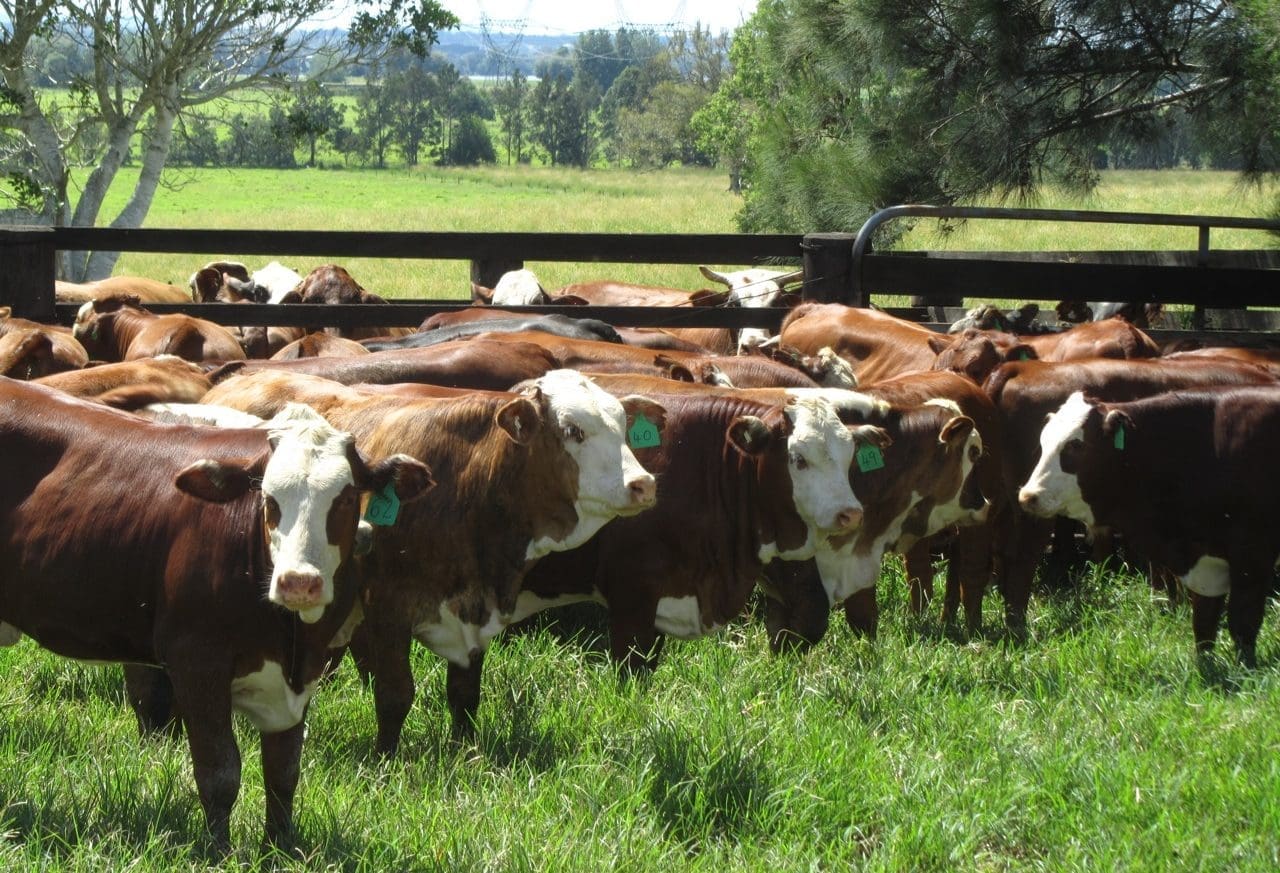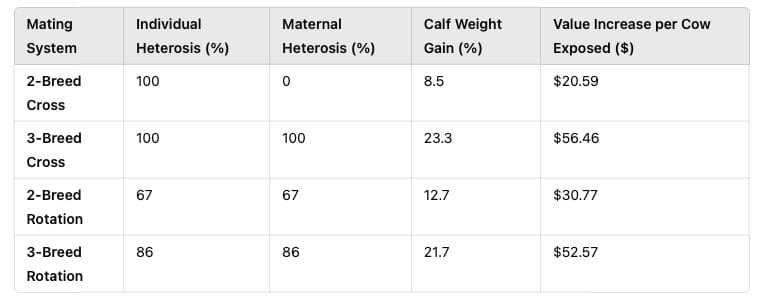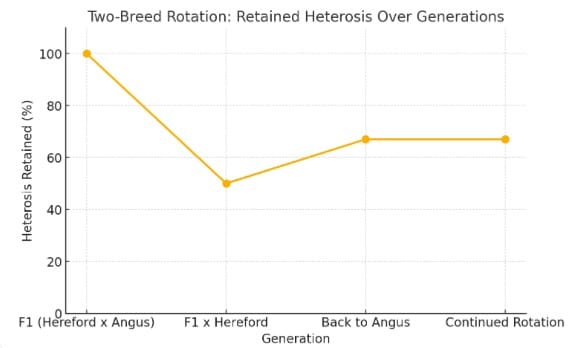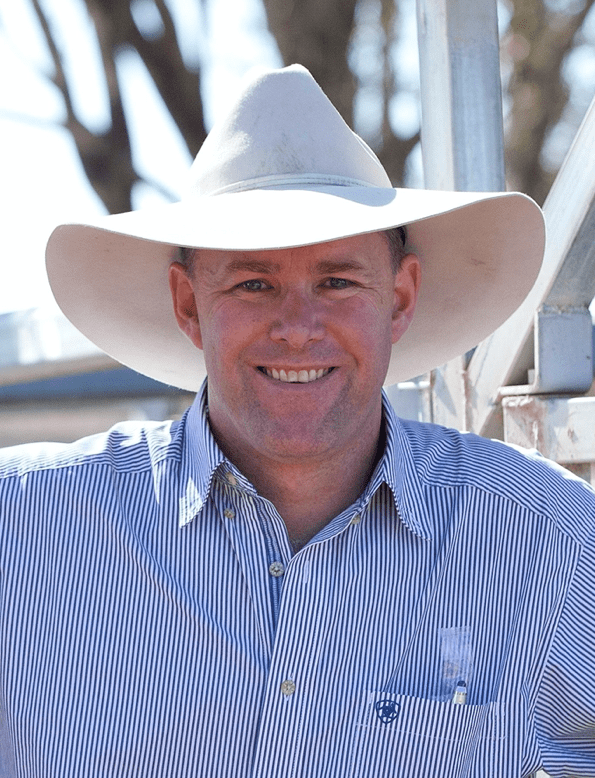This week’s column completes a two-part series looking into heterosis (hybrid vigour) as part of a ‘Crossbreeding 101 refresher’. Last week’s first instalment (click here to access) looked at the contributing effects that create heterosis, and concludes this week looking at managing heterosis in practice. The series comes in response to a recent reader inquiry (see reference at base of page) regarding the degree of heterosis he could expect in his breeding program.

Hereford x Brahman crossbreds in northern NSW
THE expression “Crossbreeding is a cattleman’s only free lunch” is often used in any discussion regarding crossbreeding.
In readers comments following last week’s first part in this series, it was noted that “crossbreeding is not rocket science. It has been scientifically proven countless times.”
While it is true that the value of crossbreeding has been proven scientifically in many projects both in Australia and overseas, it may be oversimplifying this strategy by describing it as ‘not rocket science.’
As noted at the start of last week’s column, there are many producers who are aware of the value of heterosis but are much less confident in understanding why it occurs and therefore are not placed in the best way to fully maximise its potential to improve their herds productivity and performance.
At the same time, it isn’t uncommon for breeders who use or breed bulls or females specifically for crossbreeding to advocate why their breed choice is the best option, before allowing producers to appreciate the causes and application of heterosis.
While enthusiastic recommendations or the knowledge of project results are always useful to share, it is worth spending a little time growing a foundation of understanding before choosing a crossbreeding strategy, let alone the breeds to be used in the program.
Recapping last week’s column, the key contributors to heterosis are the effects of Dominance; Overdominance and Epistasis. These three effects are expressed in the new progeny, and it is important to recognise this happens from conception and so will impact traits such as birth weight.
Heterosis is greatest when there is genetic distance between breeds. Crossbreeding with genetically closer breeds (e.g. British x British) will result in lower levels of hybrid vigour, than when two or more breed types are used (e.g. British x Indicus or European).
Heritability
Again, many producers may be aware of this result at a practical level, however there are a few other points to note before planning a crossbreeding program.
Firstly Heritability (h2), which is measured as a percentage, is the measure of variation in a trait that is due to genetics. The traits that are of heritability, generally <20pc, (or as more correctly expressed h2 <0.2) such as fertility or longevity are more influenced by the environment the animal is exposed to.
At the other end of the scale, highly heritable traits such as birth weight (h2 0.3 – 0.4) or yearling weight (h2 0.35 – 0.5) are more influenced by genetics.
In terms of the practical implications of this for a breeding objective, selection is more effective on traits that are of high heritability.
Producers wanting to improve those traits will experience better results through more accurate genetic selection than they would relying on crossbreeding and the impact of heterosis. However, if a breeding objective is to improve fertility or calf survival within a more challenging environment (either through nutrition or other factors) the impact of heterosis will offer greater results than though selection alone.
The challenge is the practical application of breeding decisions to gain the most effective improvements.
While the results of well-designed and implemented crossbreeding programs are frequently referred to by breeders and advocates of crossbreeding, there are many crossbreeding programs that have gone awry or failed to meet the breeder’s expectations. In those cases, the poor design of the program, including the wrong choice of breeds, or lack of clear focus has set many herds back several years.
Firstly, it is worth looking carefully at the retention levels of heterosis on offer in mating systems.
The table below, based on research published by organisations including FutureBeef, shows the amount of heterosis retained by the F1 animal (2 breed cross) or in a three-breed cross (e.g. British bred x British breed (F1) x European). The benefit from this program is the increase production derived from both the heterosis retained by the calf and the impact that its F1 mother also contributes (e.g. greater milk production).

Based on FutureBeef – value increase based on assumption of $2.40/kg liveweight gain cost & current EYCI
However, it is the step of joining F1 animals that often causes crossbreeding programs to lose direction or go awry.
It can be very exciting to think that a three-breed cross will result in some significant production improvements. While this is true, the choice of breeds and the resulting phenotype, often means the female progeny are less suitable to be retained as replacements.
So most three-breed crosses are often terminal programs, with producers benefiting from the individual and maternal heterosis. This does mean producers have to then source suitable replacement F1 females from outside the system. This can be sometimes a challenge due to availability; price or the simple temptation to retain an impressive heifer.
A more practical approach, particularly for breeders who want to retain their own heifers, is to follow a two (or even a three) bred rotation. In its simplest form, F1 calves (which have 100pc heterosis) are joined back to bulls from one of the parent breeds. The calves (known as F2) born from this mating will have 50pc of the original heterosis. In the following mating these F2 females are joined to a bull of the other breed used to start the program. This mating increases genetic diversity and brings the levels of heterosis up to 67pc. From then onwards these matings are maintained in order.

Crossbreeding systems can become more sophisticated than this. The key point to consider is how clear is the breeding objective that is driving a particular system.
While some producers are very confident managing complexity, including developing composite programs to capture a range of traits to meet specific environmental challenges, not all producers are as comfortable or have a need to go to this extent. In many cases two or three breed rotations offer the advantages associated with heterosis without incurring too much complexity.
The final point is to understand what happens to heterosis levels when F1 cattle are joined to similar F1 animals. The correspondent who made the initial request to us to explore this subject (see full reference at base of page) did say “I am looking to find out how much heterosis I maintain by running F1 on F1?” The short answer is that in a F1 x F1 joining, heterosis drops to 50pc in the progeny. This is largely because of gene segregation where some offspring will inherit more genes from the original parent breed than the other.

In practice this means the joining of two breeds to create an F1 sees that F1 calf receiving a mix of both breeds genes, which creates 100pc heterosis. However, when two F1 animals are mated (even though their parents were of the same two breeds) these offspring don’t inherit an even 50:50 mix of the original breeds. The random segregation of genes means that some calves will resemble one breed more than another and the recombination of genes breaks the original F1 genetic make up and reduces the level of heterosis.
Dominance effect
In last week’s column the dominance effect was outlined as a factor contributing to heterosis. As previously noted, the first-generation cross (F1) benefits from dominance effects.
In practice, recessive traits from one breed are masked by dominant traits from the other. However, as outlined above, when F1 x F1 cattle are bred, gene segregation causes some offspring to inherit more homozygous (same gene from both parents) combinations, which reduces heterosis. It is possible that over multiple generations, a stable composite breed may form, but heterosis will not be as strong as in the original F1 generation.
The most successful crossbreeding programs are those that have been well-structured, and the operators of the program have clear objectives in mind, particularly for the traits they want to improve, particularly to manage more challenging environments.
To maintain heterosis levels at a point where the effectiveness and value to a herd is maximised does take some planning and discipline to stay with the program.
However, particularly in environments where nutrition, weather or other factors pose great challenges, having focus and discipline can offer very real improvements.
Published below is the original reader comment on an earlier genetics article inquiring about the use of F1 bulls:
“I have been using Herefords on Black Angus cattle to raise the F1 cows and then I put a mixture of Herefords and Angus bulls with the F1 cows. I was getting calves that were too much Hereford or too much Angus. I bought purebred horned Hereford cows and then AI’d then to Angus bulls and kept the best bulls for myself. I am looking to find out how much heterosis I maintain by running F1 on F1?”
 Alastair Rayner is the General Manager of Extension & Operations with Cibo Labs and Principal of RaynerAg. Alastair has over 28 years’ experience advising beef producers & graziers across Australia. He can be contacted here or through his website www.raynerag.com.au
Alastair Rayner is the General Manager of Extension & Operations with Cibo Labs and Principal of RaynerAg. Alastair has over 28 years’ experience advising beef producers & graziers across Australia. He can be contacted here or through his website www.raynerag.com.au

HAVE YOUR SAY